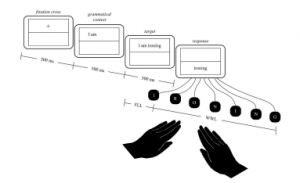¿How words ripple through bilingual hands: Sensorimotor resonance during writing in first and second language
Neuropsychologia
Kogan, B., García-Marco, E., Birba, A., Cortes, C., Melloni, M., Ibáñez, A. & García, A. M. (2020). How words ripple through bilingual hands: Sensorimotor resonance during writing in first and second language. Neuropsychologia 146, 107563. doi: https://doi.org/10.1016/j.neuropsychologia.2020.107563
En este trabajo investigamos cómo el procesamiento de palabras impacta en los movimientos corporales de sujetos bilingües. Los participantes realizaron una tarea de copia de verbos de acción en su lengua materna (L1) y extranjera (L2). Los resultados indicaron que, el procesamiento verbos que denotan acciones manuales (como ‘aplaudir’), en comparación con aquellos que denotan acciones no manuales (como ‘saltar’) acelera el movimiento de las manos en L1 pero lo ralentiza en L2. Esto sugiere que el impacto del lenguaje en los movimientos corporales depende de si el idioma en cuestión se incorporó desde la vida intrauterina (L1) o luego de la infancia media (L2).
How words ripple through bilingual hands: Sensorimotor resonance during writing in first and second language
Neuropsychologia
Kogan, B., García-Marco, E., Birba, A., Cortes, C., Melloni, M., Ibáñez, A. & García, A. M. (2020). How words ripple through bilingual hands: Sensorimotor resonance during writing in first and second language. Neuropsychologia 146, 107563. doi: https://doi.org/10.1016/j.neuropsychologia.2020.107563
The speed of our hand movements can be affected by concurrent processing of manual action verbs (MaVs). Whereas this phenomenon is well established for native languages (L1s), it remains underexplored in late foreign languages (L2s), especially during highly automatized tasks. Here we timed keystroke activity while Spanish-English bilinguals copied MaVs, non-manual action verbs, and non-action verbs in their L1 and L2. Motor planning and execution dynamics were indexed by first-letter lag (the time-lapse between word presentation and first keystroke) and whole-word lag (the time-lapse between first and last keystroke), respectively. Despite yielding no effects on motor planning, MaVs facilitated typing execution in L1 but delayed it in L2, irrespective of the subjects’ typing skills, age of L2 learning, and L2 competence. Therefore, motor-language coupling effects seem to be present in both languages though they can arise differently in each. These results extend language grounding models, illuminating the role of embodied mechanisms throughout life.
To access the full paper please click HERE



